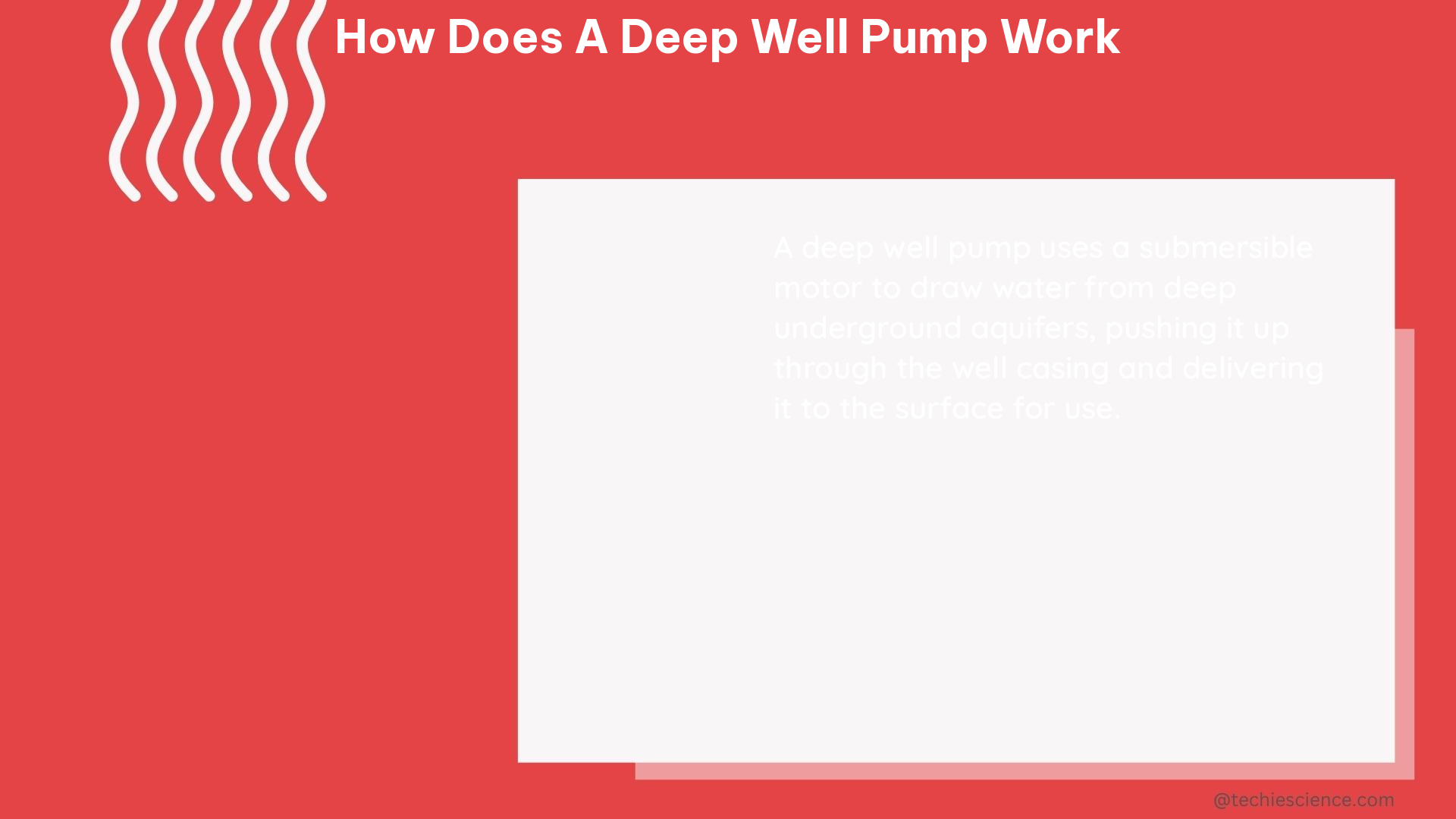A deep well pump is a specialized type of water pump designed to extract water from wells that are deeper than 25 feet. These pumps are typically submersible, meaning they are installed directly into the well and lowered to the bottom. Deep well pumps use a combination of centrifugal force and positive displacement to move water from the well to the surface.
The Components of a Deep Well Pump
The basic components of a deep well pump include:
- Pump: The pump itself, typically made up of an impeller and a diffuser.
- Motor: A motor to drive the pump, usually located above the ground and connected to the pump by a series of pipes.
- Pipes and Check Valves: A series of pipes and check valves to direct the flow of water.
Impeller and Diffuser
The impeller is a rotating component that uses centrifugal force to draw water into the pump and expel it out an outlet. The diffuser is a stationary component that helps to direct the flow of water and increase the pump’s efficiency.
Motor and Pipe Connection
The motor used to drive the pump is typically located above the ground and is connected to the pump by a series of pipes. The motor is used to rotate the impeller, which in turn draws water into the pump and expels it to the surface. The pipes and check valves are used to direct the flow of water and ensure that it moves in the correct direction.
Key Metrics for Deep Well Pumps

When evaluating the performance of a deep well pump, there are two key metrics to consider:
- Flow Rate: Typically measured in gallons per minute (GPM), the flow rate of a deep well pump is determined by factors such as the size of the pump, the speed of the impeller, and the pressure differential between the well and the surface.
- Efficiency: A measure of how much of the energy consumed by the pump is actually used to move water. Deep well pumps typically have efficiencies of around 50-60%, although some high-efficiency models can achieve efficiencies of up to 80%.
Selecting the Right Deep Well Pump
When selecting a deep well pump, it’s important to consider several factors:
- Well Depth: For wells deeper than 100 feet, a submersible pump is typically the best option, as these pumps are designed to be lowered to the bottom of the well and can handle the high pressures associated with deep wells. For shallower wells, a jet pump may be more appropriate.
- Well Diameter: The diameter of the well can also impact the type of pump required.
- Flow Rate: The required flow rate, measured in GPM, is another important factor to consider.
- Power Supply: The available power supply must be compatible with the pump’s motor.
- Water Quality: Some pumps are better suited to handling dirty or sediment-laden water than others.
Calculating the Lift Head
To determine the required lift head for a deep well pump, you’ll need to consider the following:
- Well Depth: The depth of the well, typically measured in feet.
- Pipe Length: The total length of the water pipe, also measured in feet.
- Total Loss Head: The sum of the friction loss in the water pipe and the pressure loss due to the pump, measured in feet.
The lift head is the height that the water must be lifted from the bottom of the well to the surface, and is typically measured in feet.
Selecting the Appropriate Impeller Series
Once the lift head and flow rate have been determined, you can select a pump impeller series that is appropriate for the application. The impeller series is typically determined by the pump manufacturer based on the lift head and flow rate, and is expressed as a ratio of the lift head to the flow rate.
In summary, deep well pumps are specialized water pumps that use a combination of centrifugal force and positive displacement to extract water from wells deeper than 25 feet. Understanding the key components, metrics, and selection factors is crucial for ensuring the proper operation and performance of a deep well pump.
References:
– Increasing Energy Efficiency in Water Collection Systems by Submersible PMSM Well Pumps, 2018. https://www.mdpi.com/2073-4441/10/10/1310
– What data should be calculated when deep well submersible pump is used, 2017. https://www.linkedin.com/pulse/what-data-should-calculated-when-deep-well-pump-used-hellen-jiang
– What Pump is in my Well? – YouTube, 2018. https://www.youtube.com/watch?v=cWksNcUqWdE
– How to Measure Your Well Pump GPM – YouTube, 2019. https://www.youtube.com/watch?v=5J1MaIyMSOQ
– What Is a Well Pump and How Does It Work? – Fresh Water Systems, 2024. https://www.freshwatersystems.com/blogs/blog/what-is-a-well-pump-and-how-does-it-work

The lambdageeks.com Core SME Team is a group of experienced subject matter experts from diverse scientific and technical fields including Physics, Chemistry, Technology,Electronics & Electrical Engineering, Automotive, Mechanical Engineering. Our team collaborates to create high-quality, well-researched articles on a wide range of science and technology topics for the lambdageeks.com website.
All Our Senior SME are having more than 7 Years of experience in the respective fields . They are either Working Industry Professionals or assocaited With different Universities. Refer Our Authors Page to get to know About our Core SMEs.